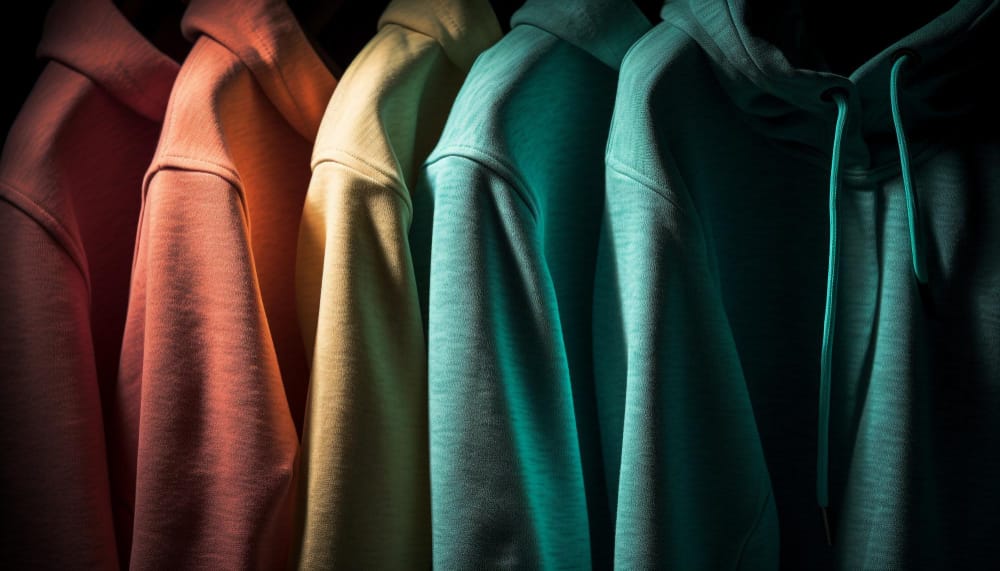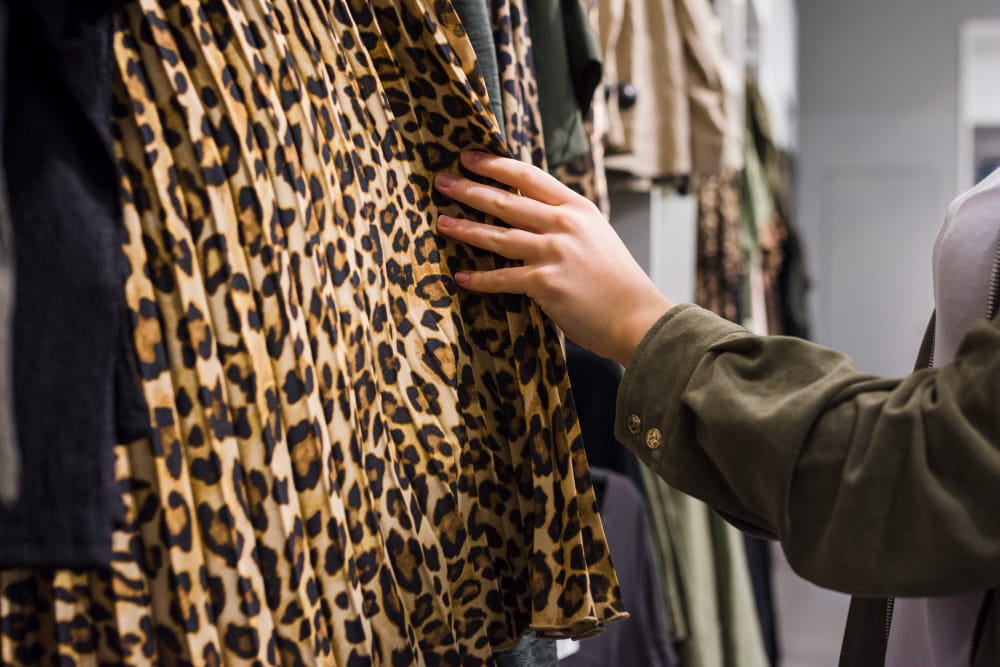Home » Modal
Modal Fabric: The Ultimate Luxury in Jersey Textiles
Modal fabric is a luxurious jersey textile known for its exceptional softness and lustrous sheen. This versatile fabric has gained popularity in the fashion industry for its luxurious feel and eco-friendly production process. In this blog post, we will delve into the world of modal fabric, exploring its unique properties, sustainability benefits, and its future in the fashion world.

What Is Modal Fabric, and How Is It Made?
Modal fabric belongs to the viscose family, distinguished by its source material – the pulp of beech trees. Its creation involves a meticulous process where the cellulose extracted from these trees is transformed into fibres. These fibres are then spun and woven into the fabric that boasts a remarkably smooth texture. Its production not only highlights the innovation in textile technology but also showcases an approach that favours sustainability. The conversion from tree pulp to fibre emphasises a closed-loop process, where solvents used in creating modal are recycled, minimising waste and environmental impact. This process results in a material that surpasses the softness and breathability of many natural fabrics, including cotton, making modal fabric a preferred choice for designers seeking to combine luxury with eco-consciousness. Its application spans a wide array of high-end clothing options, illustrating the versatility and desirability of this sophisticated textile. Through its unique production journey, modal fabric emerges as a pinnacle of softness and sustainability in the modern fashion landscape.
The Remarkable Properties of Modal Fabric
Modal fabric sets itself apart in the textile industry through its array of exceptional qualities that cater to both luxury and practicality. Its unrivalled softness ensures a tactile experience akin to silk, offering unparalleled comfort to the wearer. The inherent lustrous sheen of modal adds a visually appealing dimension to garments, enhancing their aesthetic with a subtle glow that exudes elegance. This fabric excels in moisture management, with its high absorbency and breathability ensuring that it remains dry and comfortable even in warm climates. This characteristic makes it particularly suited for active wear and intimate apparel, where comfort and hygiene are paramount. Additionally, modal is celebrated for its colour retention abilities, allowing garments to maintain their vibrancy wash after wash. This durability, coupled with its resistance to shrinkage and pilling, establishes modal fabric as a premier choice for both everyday wear and high-end fashion items. Its thermal-regulating properties also stand out, providing insulation during cooler temperatures whilst ensuring coolness in the heat, thus offering year-round comfort. The combination of these properties ensures that modal fabric not only meets the demands of contemporary fashion but also exceeds expectations in terms of comfort, appearance, and functionality.

Modal Fabric vs. Other Jersey Fabrics: A Comparative Analysis
In a detailed exploration of modal fabric compared to other jersey textiles, it becomes evident why modal stands in a league of its own. When juxtaposed with cotton, a fabric renowned for its breathability and natural origins, modal fabric shines due to its enhanced softness and a texture that closely mimics silk. This elevates the tactile experience for the wearer, offering a superior level of comfort and luxury. Unlike polyester, a common choice for jersey fabrics that may impart a synthetic feel and lacks breathability, modal excels in offering a skin-friendly alternative. Its moisture-wicking properties are far superior, ensuring that it remains comfortable to wear in varying temperatures, a feature polyester struggles to match.
Beyond comfort, modal fabric demonstrates exceptional colour retention and resistance to shrinkage, issues that often plague cotton and polyester garments after repeated washing. This attribute ensures that items made from modal fabric retain their aesthetic appeal and structural integrity over time, distinguishing it from its counterparts in durability and ease of maintenance. Furthermore, the environmental footprint of modal, derived from sustainably harvested beech trees and produced through an eco-conscious process, presents a stark contrast to the resource-intensive cultivation of cotton and the petrochemical origins of polyester. This comparative analysis highlights not only the tactile and aesthetic superiority of modal but also its role in promoting more sustainable fashion practices.
Caring for Your Modal Fabric Items
Maintaining the exquisite softness and sheen of modal fabric garments requires a gentle approach to laundering. It’s advisable to machine wash these items using a delicate cycle, paired with mild detergents that are free from harsh chemicals, to preserve the integrity and luminous quality of the fabric. Bleach should be strictly avoided, as it can degrade the modal fibres, diminishing their natural lustre and softness. For drying, opting to air dry modal items not only contributes to retaining their shape and texture but also aligns with the fabric’s eco-friendly ethos.

If you must use a tumble dryer, select a low heat setting to prevent any potential shrinkage or damage to the fibres. Ironing should be undertaken with caution; a low heat setting and a protective pressing cloth between the iron and the modal fabric will help avoid heat damage, ensuring your garments remain impeccable. Following these care tips will extend the life of your modal fabric items, allowing you to enjoy their luxury and comfort for longer.
The Sustainable Choice: Modal Fabric’s Environmental Impact
Modal fabric represents an eco-conscious selection within the textile industry, underscored by its lower environmental footprint in comparison to traditional fabrics. The production process of modal is inherently more resource-efficient, requiring significantly less water and energy than is typically consumed in the manufacture of other textiles. This efficiency is a pivotal aspect of its sustainability credentials. Furthermore, the source of modal fabric, beech trees, plays a crucial role in its environmental appeal. These trees proliferate without the need for artificial irrigation or planting, thus presenting a self-replenishing resource that minimises ecological disruption. The harvesting process respects the natural cycle of these forests, ensuring that the ecosystem remains balanced and biodiversity is preserved.
In addition to its renewable origins, the modal production process exemplifies environmental stewardship through its reduced chemical usage. The closed-loop process recycles the chemicals used in production, thereby mitigating potential pollution and waste. This commitment to reducing chemical and resource use highlights the modal fabric’s alignment with sustainable manufacturing practices. The resultant fabric not only embodies the pinnacle of luxury and comfort but also stands as a testament to the possibility of harmonising high-quality textile production with environmental responsibility. Through these practices, modal fabric contributes to a more sustainable fashion industry, offering a material solution that supports both the planet and the needs of the modern consumer.
Where to Find Modal Fabric Products
Discovering modal fabric items has become an effortless journey, thanks to its burgeoning presence across a wide spectrum of luxury and eco-conscious fashion lines. Esteemed for its sumptuous texture and sustainability, modal fabric graces the collections of numerous high-end labels, enriching the fashion landscape with its elegance and ethical appeal. Lingerie, renowned for demanding the utmost in comfort and tactile pleasure, frequently features modal fabric, alongside sleepwear collections that promise unparalleled softness for a restful night’s sleep. Activewear infused with modal fabric offers a fusion of functionality and luxury, enhancing workout sessions with its breathable, moisture-wicking properties.
In addition to apparel, modal fabric extends its reach into the domain of home textiles, presenting an opportunity to envelop your living environment in its lavish softness. Bedding crafted from modal fabric transforms the sleep experience, combining breathability and moisture management to ensure a comfortable, restful slumber. The pursuit of modal fabric products is facilitated by specialty boutiques and online platforms that champion sustainable and luxury textiles, reflecting a growing consumer shift towards environmentally responsible and high-quality materials.
As the textile industry evolves, modal fabric remains at the forefront, accessible through venues that align with its values of luxury, comfort, and sustainability. Whether updating one’s wardrobe or enhancing the home, modal fabric products offer a seamless blend of ethical manufacturing and opulent comfort, easily found in select stores and through digital marketplaces that specialise in premium, eco-friendly fashion.

The Future of Modal Fabric in Fashion and Beyond
The trajectory of modal fabric within the realms of fashion and textiles is set to ascend as awareness and preference for sustainable and ethically produced materials rise amongst consumers and designers. Its inherent qualities of softness, versatility, and eco-friendly production position modal as an ideal choice for a wide array of apparel and home textiles. The evolving landscape of the fashion industry, increasingly influenced by calls for environmental stewardship and ethical manufacturing, aligns perfectly with the attributes of modal fabric.
This synergy suggests a bright future where modal’s prevalence extends beyond luxury wear into more segments of everyday fashion and household items. With ongoing advancements in textile technology and a growing emphasis on circular economy principles, modal fabric’s role is anticipated to expand, further embedding its status as a cornerstone of sustainable fashion innovation. As the industry shifts towards more responsible practices, modal fabric stands at the cusp of becoming a key player in redefining textile excellence for a conscious generation.